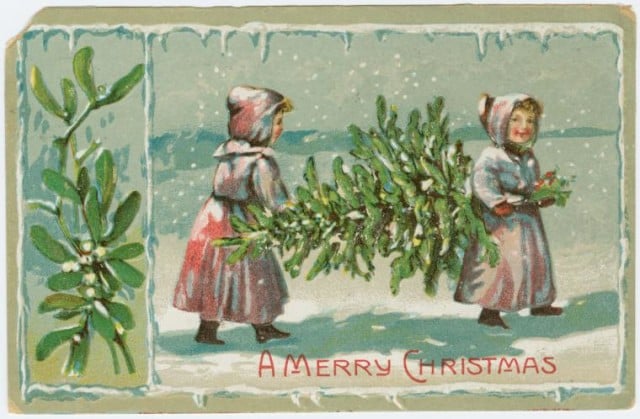Art & Exhibitions
Vintage Cheer from the NYPL Picture Collection
THE DAILY PIC: Now 100 years old, the Collection circulates some million images.

THE DAILY PIC: Now 100 years old, the Collection circulates some million images.

Blake Gopnik


THE DAILY PIC (#1460): Merry Christmas and Best of the Season from the Daily Pic, which will be going dark and un-daily for the coming holiday week.
Those best wishes come via this lovely old postcard, mailed 105 years ago today; it now counts as one tiny part of a giant and ongoing gift to New Yorkers that few of us even know we are getting. The card is one of 1.3 million items included in the New York Public Library’s great Picture Collection, which was launched a century ago. A small sample of its holdings is now on display in the exhibition “100 Years of the Picture Collection: From Abacus to Zoology”, mounted on the first floor of the library’s main building. (You turn left at the giant Christmas tree.)
Those of us who work on the city’s 1950s cultural scene know that the Collection was in constant use in those pre-Google days, as artists went to it for source material: A huge number of Andy Warhol’s commercial works were based on images he borrowed from NYPL. (He often failed to return them: His archive in Pittsburgh still has a bunch, and I’ve also seen statements for library fines.) What I, for one, did not realize is that the Collection is still going strong. It is in constant, happy use on the third floor of the Mid-Manhattan branch of the library, catercorner to the great NYPL lions.
Costume and set designers use the Collection to get their history right: Mad Men would have missed out on some 1960s details if not for old pictures from NYPL; how else could designers have learned the look of high-end shopping bags from that era? “We were clipping things as they happened,” explained Billy Parrott, the librarian in charge of the collection, which means there are pictures that might not otherwise have survived.
The collection’s images have mostly been snipped from magazines and surplus books, and are organized under 12,000 subject headings. They are meant to provide “a visual snapshot of the world,” Parrott told me, for anyone at all who wants to come by to consult or borrow them. Many creatives still head to the collection for inspiration that can be richer, and stranger, than the Web can provide: As Parrott put it, “artists don’t want to see something that an algorithm wants them to see.”
For a full survey of past Daily Pics visit blakegopnik.com/archive.